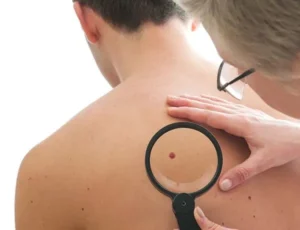A common mole is a coloured mass that can occur anywhere on the body in both men and women. Melanocytes, which are pigment cells, grow into clusters which form the mole, or nevus. Though common moles are seldom a serious issue (rarely do they develop into melanoma), one should seek advice to have moles checked by a professional if any of the following are experienced:

What to look for when inspecting your moles
- A change in colour, shape or size
- Moles become dry, scabby or itchy
- Bleeding or weeping
- Uncomfortable in any way
Professional consultation and mole diagnosis at Wentworth Clinic
We have many years’ experience in diagnosing and treating patients who are unhappy with the appearance of common moles. Our skincare Consultant will check your moles using magnifying glasses and a dermatoscope, and once a diagnosis has been made then we will discuss your mole treatment options, advising on the best possible treatment for your particular skin condition to ensure you achieve the results you are looking for.
Skin mole removal treatment
If the mole is a benign lesion, treatment would be excision and primary repair, or ablation with the Erbium laser. However, if malignancy is suspected then a biopsy is essential.
All of the mole removal procedures we offer at Wentworth Clinic are performed by a qualified skincare Consultant and are removed without pain – minimal scarring may be visible.
If you are concerned about a misshapen, or uncomfortable mole then contact our Bournemouth Clinic to arrange a private consultation. Call our office today, or complete the online contact form and one of the Wentworth team will respond to your enquiry shortly.
You can find out more about our common mole removal procedures, and post-treatment care below.
